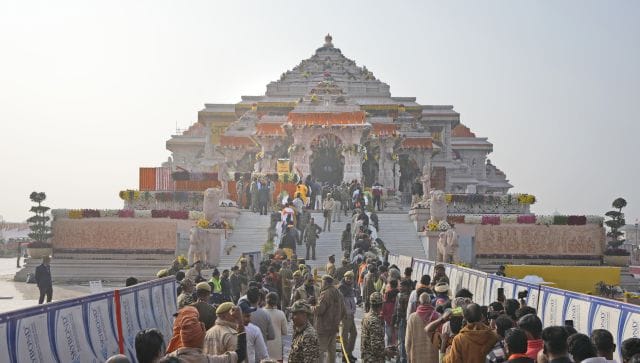It has been an eventful week for India. Monday started on a spiritual note for Hindus in the country and the world over with the consecration of the Ram mandir in Ayodhya.
Millions tuned in to get the first glimpse of the Ram Lalla idol, as Prime Minister Narendra Modi performed rituals. With the temple now open to the public (we’ve all seen images of the crowd), Ayodhya is bracing for a big change. The city is now a brand in itself and there are many takers.
The mandir will bring economic benefits to Ayodhya and the rest of Uttar Pradesh. For the Bharatiya Janata Party, it is a big brownie point ahead of the 2024 Lok Sabha polls.
However, all’s not well with the INDIA bloc. Mamata Banerjee and Bhagwant Mann have decided to go it alone in the upcoming elections. And there is talk that Nitish Kumar might quit the alliance. How will the opposition parties take on the BJP?
Meanwhile, PM Modi has his eyes set on the goal. After the opening of the mandir, he kicked off the 2024 poll rally from Uttar Pradesh. Then came the roadshows and talks with France’s Emmanuel Macron, India’s chief guest for the Republic Day. This was followed by the parade and celebrations on 26 January, the country’s 75th R-Day. We’ve been tracking all these developments closely.
In our roundup of explainers, we take a look back at the week that was.
1. The Ram mandir is good for business. Ayodhya is the new destination for investment. From real estate developers to hotel owners, from airlines to travel companies, all eyes are set on the town in eastern Uttar Pradesh. It means more jobs for locals and more money for the state. In this story, we explain how the temple will change the fortunes of Ayodhya and the neighbouring cities.
2. The Ram temple and its opening have been a sensitive issue. The foundations of the dispute were laid in 1528, when Mir Baqi, a deputy of the Mughal emperor Babur, built the Babri Masjid over what was believed to be the ruins of a Hindu temple. Then in 1949, Ram Lalla’s idols were placed inside the mosque, opening the floodgates of suits. Court cases were fought, laws were fought, and a lot more before the big Supreme Court verdict. We take a look at the past and how Ayodhya got its mandir back after 500 years.
3. The temple opening was celebrated across India with great fervour. People lit up their homes and burst firecrackers. However, there were sporadic tensions, especially in Maharashtra. Mira Road, a suburb on the outskirts of Mumbai, saw violence. In Pune, a clash broke out between members of Hindutva outfits and students of the Film and Television Institute of India (FTII). Here’s what happened.
4. The second big event on the week was the Republic Day, India’s 75th. For the momentous occasion, French president Emmanuel Macron was the chief guest. On Day 1 of his visit, he toured the Amer fort, participated in a roadshow with the PM, and held talks.
Macron’s trip came after Modi visited France for Bastille Day celebrations. The two countries have had good ties for decades, celebrating 25 years of strategic partnership last year. We take a look at the New Delhi-Paris friendship and what makes it special.
5. India’s 75th Republic Day celebrations left everyone wowed. The highlight of 26 January was the military parade, which featured several contingents from the Indian Army, Air Force, Navy, and other para-military forces. It was an impressive display of tanks, missiles, fighter jets and more.
The parade has now become an R-Day tradition. Thousands beat the cold and gathered at Kartayva Path to witness the spectacle and lakhs and lakhs more tuned in to their television sets or watched it online.
But why does India display its military prowess on this day? How did this march come into existence? We take a look back at the history of such parades and their significance.
6. The INDIA alliance is in trouble. First Mamata Banerjee and Bhagwant Mann decided to go it alone in West Bengal and Punjab in the Lok Sabha polls. And now the mess in the Mahaghatbandhan government in Bihar is unfolding. There are reports that Nitish Kumar will switch sides and take oath on Sunday as Bihar chief minister for the ninth time with the support of the Bharatiya Janata Party (BJP). Why is Nitish in ‘paltu ram’ mode again? And what could this mean for politics in Bihar? We explain.
7. This week gave Indians several reasons to cheer. One of them was a personal benefit. On 25 January, general and health insurance companies rolled out the “Cashless Everywhere” initiative. Now policyholders have the freedom to choose any hospital for treatment. Here’s how it will work.
That’s all for now. Happy weekend! If you like the way we explain and help you understand the news, watch this space for more.
PS: It’s a long weekend and if you have opted for “Dry January”, this could interest you. Can the liver heal itself if you give up alcohol? Find out here.
Link to article –
This Week in Explainers: Why is Nitish Kumar back to his ‘paltu ram’ ways?





